What can you learn about your lemon or orange, mandarin or grapefruit tree from its leaves?
Following are photos of citrus foliage mostly from the trees in my own Southern California yard, and each photo tells a small story. It’s likely that you’ll recognize some of the colors, shapes, and critters in the images. And I’m guessing that knowing why the leaves look as they do can bring comfort, satisfy curiosity, or help you care for your trees.
Zig zag tracks: leafminers

Ubiquitous on leaves of citrus trees in Southern California are the squiggly tracks of the larva of the citrus leafminer. The above photo shows a fresh track, where the larva is still in the tunnel. The photo was taken in the middle of summer, when many citrus trees are putting out new leaves and the citrus leafminers are very active.
After the larva have emerged from their tunnels, they pupate and curl the leaf around them. Eventually, they become small moths, and they leave behind distorted foliage: tracked, curled, shiny, with dead spots.

Are leafminers a significant threat to your citrus tree? What should you do about them? See my post, “Don’t spray for citrus leafminers.” Also, learn a lot more about citrus leafminers at this page from the University of California.
Cupping upward: thirsty
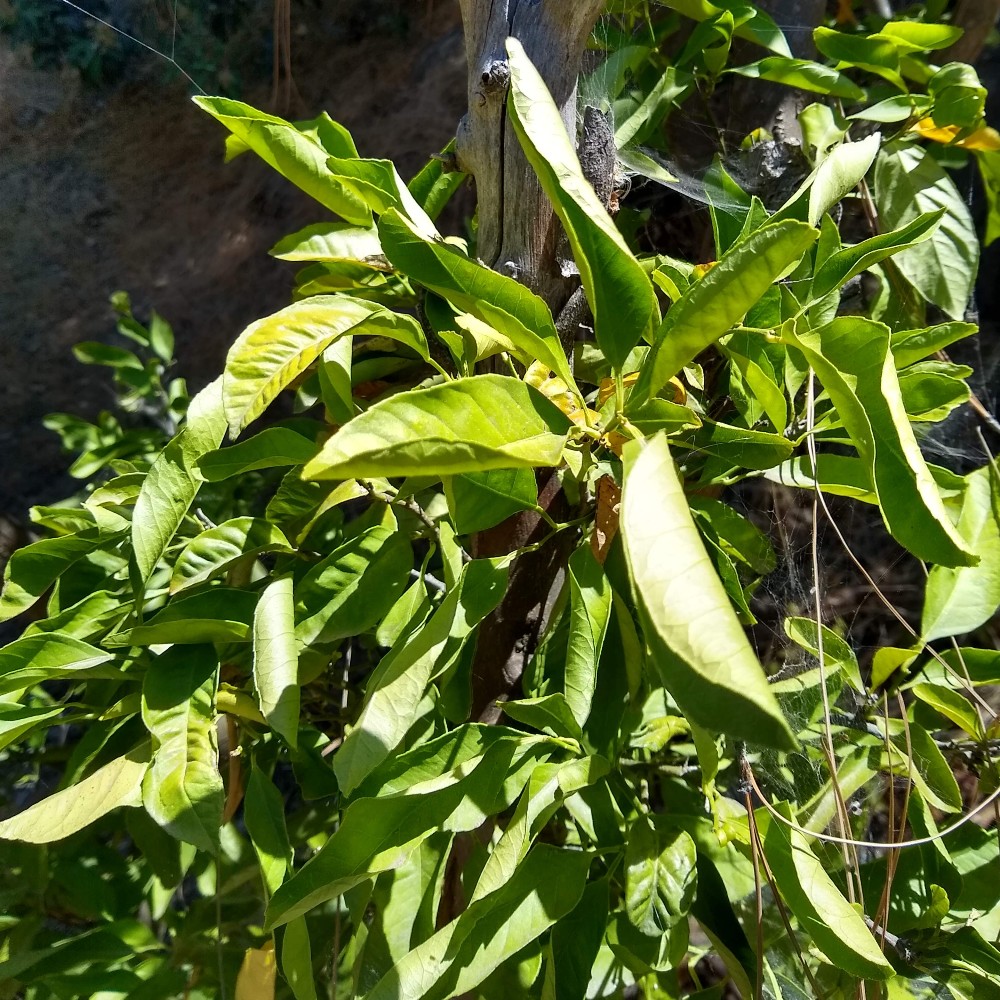
I greatly appreciate how citrus trees make it known that they need water: they roll their leaves like taco shells. I happen to have a handful of old citrus trees in my yard that I don’t much care about and that I rarely, if ever, irrigate. So right now, mid-summer, most of them have cupped leaves like the one in the photo above. On occasion, I water one of these trees, and I enjoy watching the leaves unroll over the next few hours.
We can use this signal of cupped leaves to notice when citrus trees need water. Conversely, we can use the absence of cupped leaves to confirm that a citrus tree does not currently need water.
(More on this topic in my post, “Watering citrus trees in Southern California.”)
Small yellow leaves: new growth
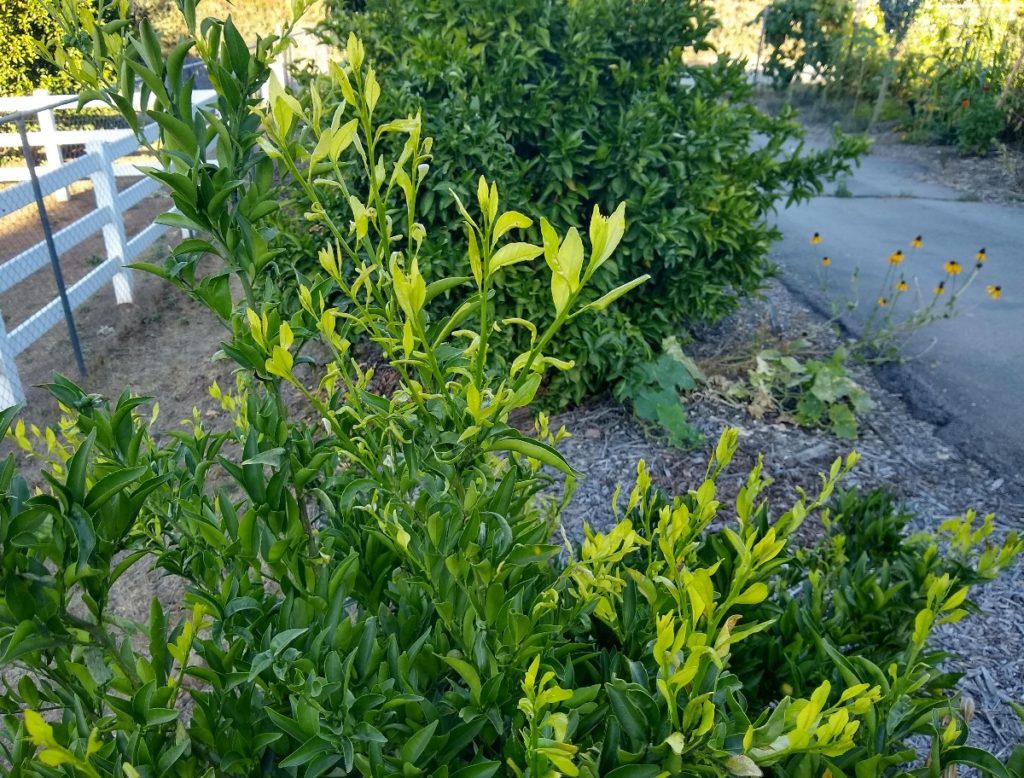
We are naturally suspicious of yellow leaves. Healthy leaves are supposed to be green, right? That’s a good rule of thumb, but it doesn’t apply to the little new leaves that emerge in pulses throughout spring and summer. Often this new growth is slightly yellow, and on some varieties of citrus it is extremely yellow. It can look sickly, but isn’t necessarily so. As the leaves mature, they green up just like the rest of the older foliage.
(Yellow on older leaves can be a sign of overwatering or nutrient problems. See here for images that help diagnose patterns of yellow on citrus leaves.)
Deep green leaves: north side

Speaking of green leaves, have you ever noticed that the leaves on the north side of a citrus tree’s canopy are greener than the leaves on the south side? (It’s reversed in the Southern Hemisphere.) This is exaggerated in hot inland locations.
In fact, if your normal view of your citrus tree is of the north side of its canopy, then you might think the tree is healthier and more beautiful than if your normal view is of its south side.
My normal view of the above Valencia orange tree is of its north side, which is so pleasing to look at. When I see the tree from the other side, I would wonder if it didn’t need more water or fertilizer, if I didn’t know better.
Yellow areas on south side: sunburn
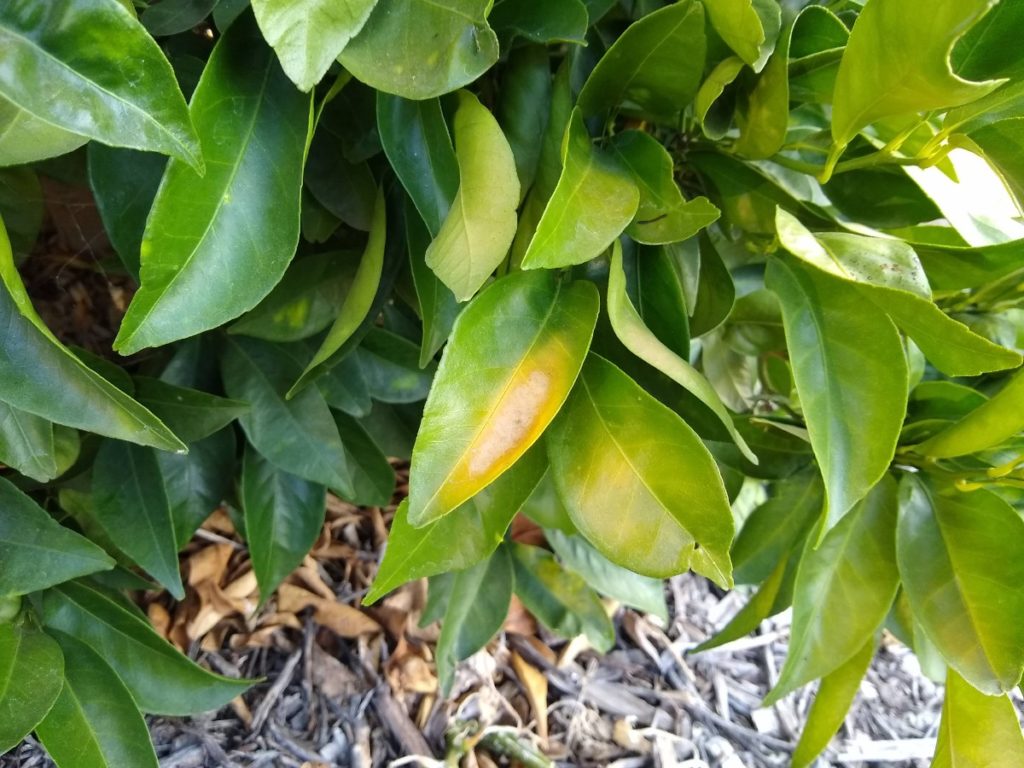
This photo shows some leaves on the south side of my Cara Cara navel orange tree. Unfortunately, I almost never see this tree’s greener north side. Moreover, the tree is planted beside our driveway, which adds to the intensity of the heat and sunlight that this south side of the canopy receives.
So not only is the south side less green overall, but it also has leaves with yellow areas. And if there’s been a heat wave, parts of those leaves will get so scorched that they turn light brown. It’s not a disease or an insect or a nutrient deficiency; it’s just too much sun.
Yellow mottling: sap suckers
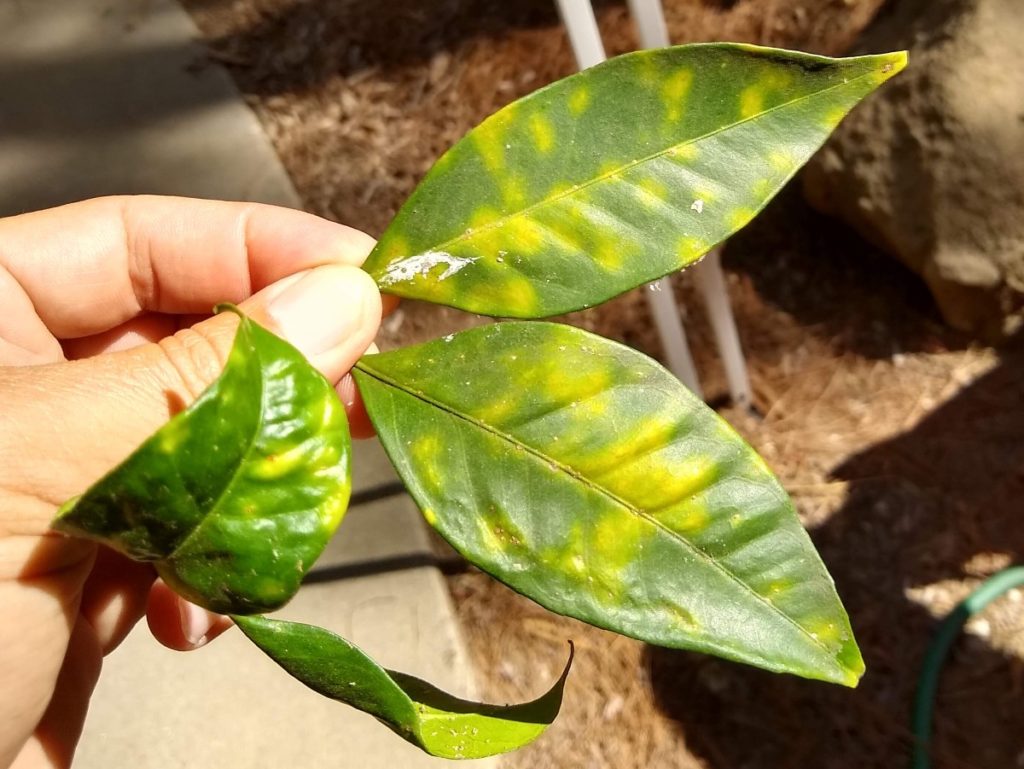
However, citrus leaves do show yellow spots that are caused by diseases or insects or nutrient deficiencies, of course. How do you know which is which? One way is to flip the leaf over.
White fluff on bottom side: woolly whiteflies
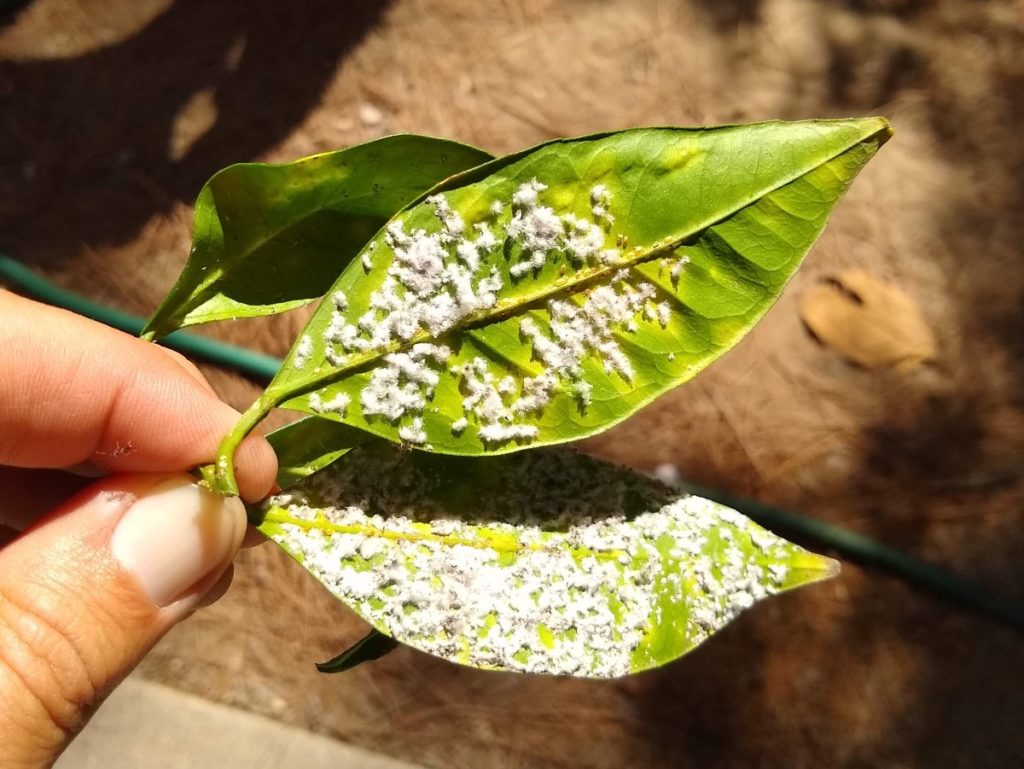
You might find tiny insects on the underside of the leaves that are sucking the juices from the leaves and causing the mottled colors on top, such as in the photo above which shows numerous woolly whiteflies on some leaves from my Valencia orange tree.
(Here are details on managing whiteflies on citrus trees from the University of California.)
Other sap suckers found on citrus leaves include aphids and scale.
Orange/brown bumps: scale
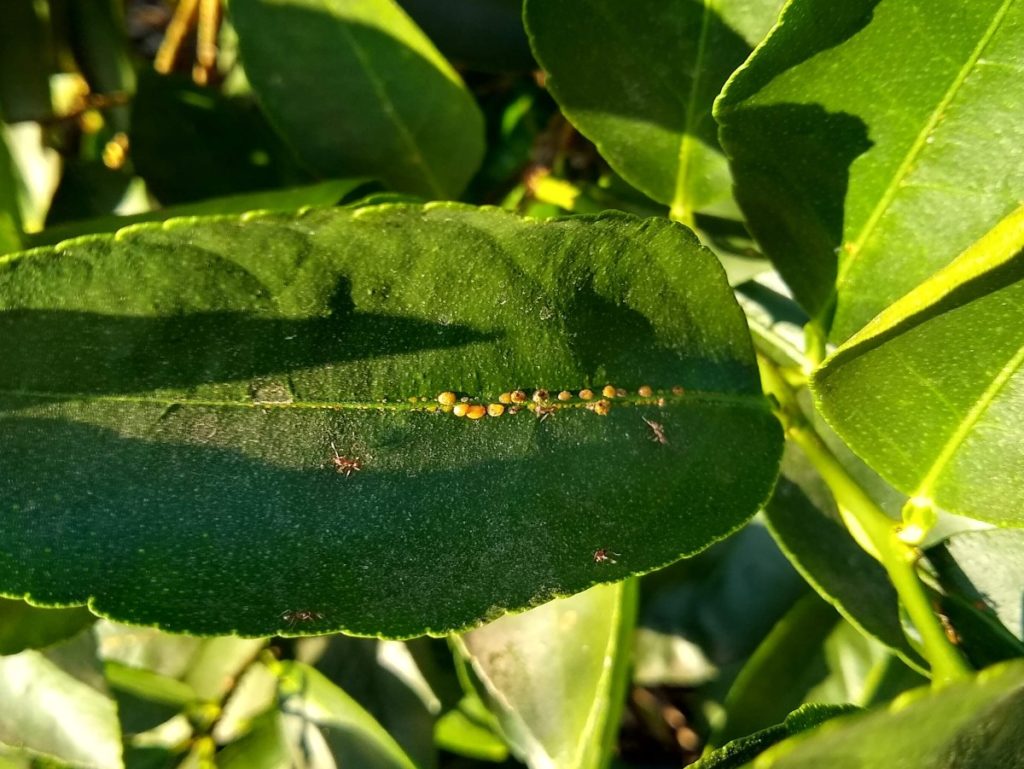
Scale is in love with my Bearss lime tree. The orange/brown bumps can be found all over the branches and on some leaves too. Unlike woolly whiteflies, scale seems to like living on both the bottom and the top sides of the leaves.
Note the presence of ants in the photo above. If you look closely, you’ll also notice ants in the photo of woolly whiteflies. At the end of this post, I’ll comment on the significance of the presence of these ants.
(Here are details on managing brown soft scale from the University of California.)
Three-leaved clusters: rootstock
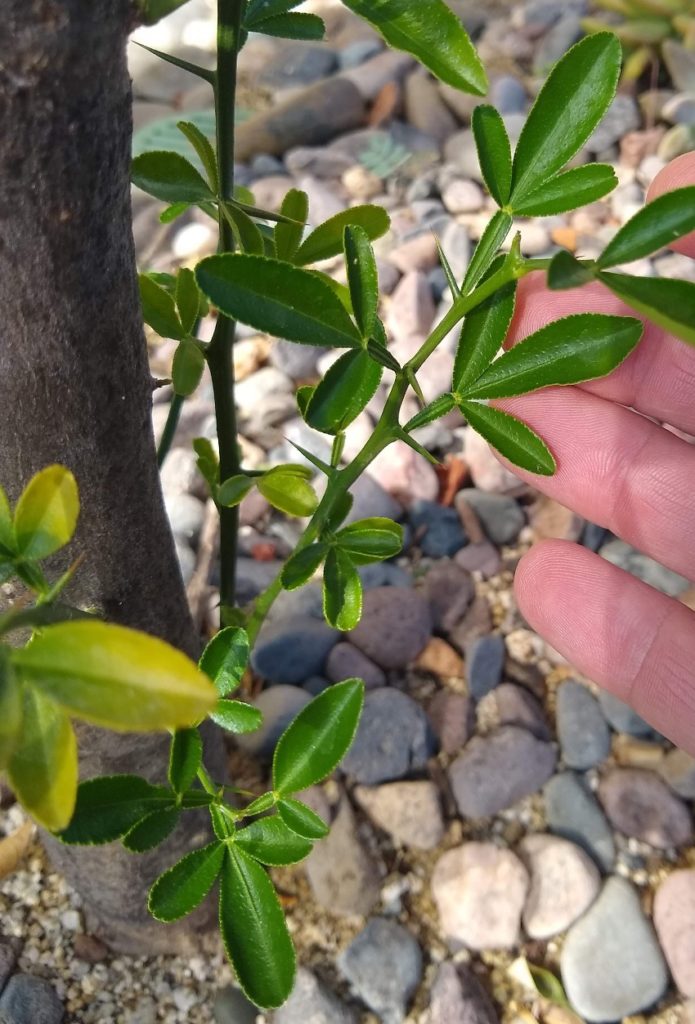
It can pay dividends to notice the shapes of the leaves of your citrus tree. All of the leaves on a tree should have a similar shape. If some don’t, then you might be looking at a tree whose rootstock has been allowed to sprout.
A common type of rootstock used today to make the citrus trees that we grow in California is a type of trifoliate, meaning that it has groups of three leaves or leaflets. So look out for those clusters of three leaves, accompanied by lots of thorns on the branches.
(What to do if you find them? See my post, “Beware of rootstock suckers on citrus trees.”)
Wilted and water soaked: cold damage

If in the winter some of the leaves on the outside of a citrus tree’s canopy, especially small new leaves, look wilted, darkened, like they’re water-soaked, then you’re looking at cold damage.
Black film: sooty mold
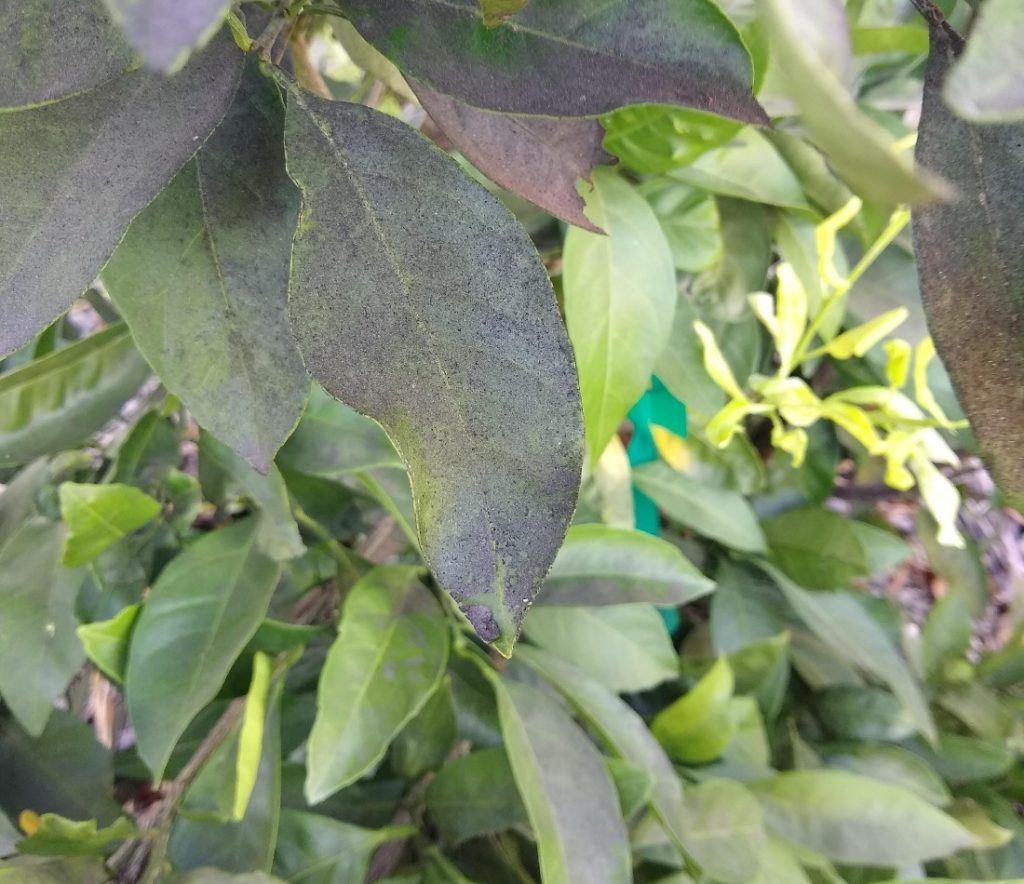
If it’s not winter and the leaves on a citrus tree look blackened, then you might be dealing with a fungus called sooty mold, which seems to be most prolific on citrus trees near the beach, in my observations, but even my Satsuma mandarin tree in inland Ramona has some.
Sooty mold grows on the sweet excrement, called honeydew, produced by sap-sucking insects like woolly whiteflies, aphids, and scale.
(Here are details on managing sooty mold from the University of California.)
Argentine ants and citrus leaves
Remember the ants that I pointed out in the photos above? They weren’t there incidentally. They were Argentine ants, and they farm those sap-sucking insects. The Argentine ants eat the honeydew that the sap suckers excrete, and then the ants herd and defend the sap suckers, their food source.
If you find sap-sucking insects on your citrus leaves, I guarantee you’ll also find ants.
If you get rid of the ants, then the population of sap-sucking insects will be vastly reduced by predators, parasites, and pathogens. Without the ants to defend them, the sap suckers are vulnerable.
Mark Hoddle, entomologist at U.C. Riverside, reports getting over 90-percent reductions of sap-sucking insect populations in citrus groves through merely reducing the Argentine ant population. Getting rid of the ants allows the natural enemies of the sap suckers to do their work. Hoddle finds it most effective to kill Argentine ants through some form of bait and poison. One example of this that is available to home gardeners for purchase is the KM AntPro bait station.
It’s a wild world out there. There are lots of environmental stresses, and there are bugs and microbes that feed on our citrus leaves. But don’t automatically worry at the sight of imperfect leaves. Do automatically try to learn their stories.
A list of all my Yard Posts is HERE

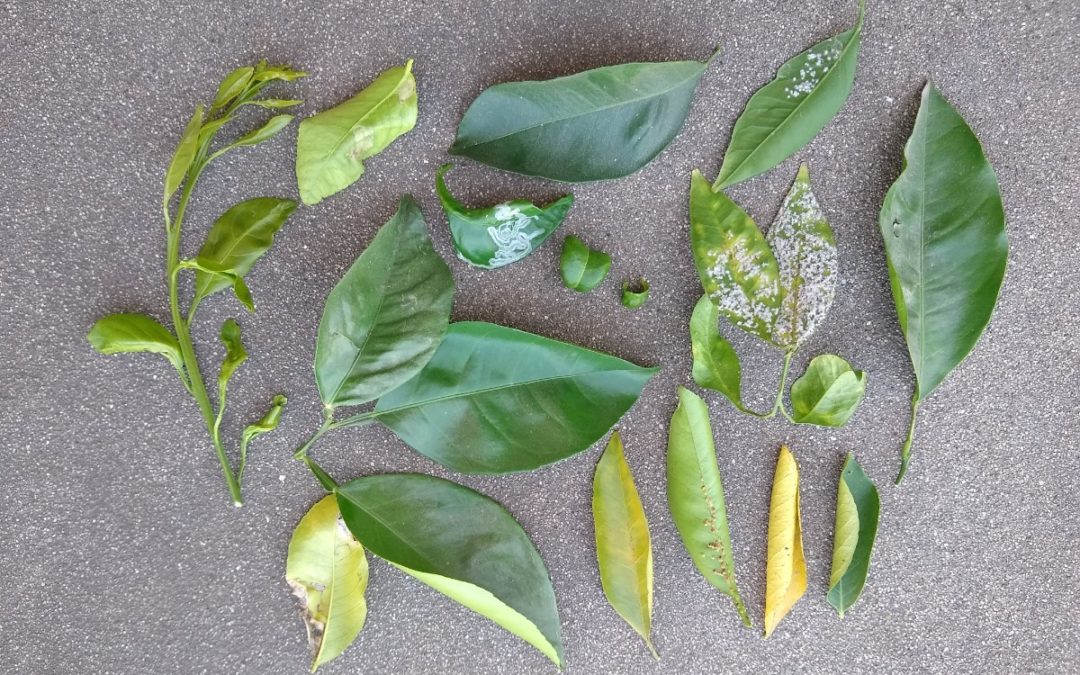


I learned a great trick to keep the ants off of my citrus trees. Put a ring of Vaseline around the trunk the ants can’t get across the barrier.
Hi Gina,
I haven’t tried Vaseline. Has that worked long term for you? I’ve tried duct tape (sticky side out) and Tanglefoot, both of which work temporarily but eventually the ants cover the sticky surfaces with dead bodies, the dead bodies becoming a bridge for new ants to cross. These methods have required frequent maintenance or renewal for me.
When I see ants going up the trunk of a tree, I know they are farming. I trace the ant trail to locate their underground home. Then I flood the area with water, so they come out of the ground carrying white things (ant young?) Then I spray them with a mixture of water and dish soap. Then I spray the trail of ants all the way up to inside the tree. That stops the ant problem for a long time.
I have a grapefruit tree that has its leaves curled inward and has no new growth. Tried more watering but doesn’t seem to be helping. The tree is still green and thorns are still sharp. Any ideas?
Hi Frank,
Did the watering change the curl on the leaves? If there was no response, it could be because there is root damage that is preventing the tree from taking up the water.
Hello, I also have curled leaves on my lime. Water does not relieve it. The young leaves are curling and the older leaves are curling and the ends look yellowed and tough. I live in california and water thoroughly about once a week. The tree was put in one year ago. I e fed it with citrus food 4 times( once each quarter year)
Hi Theresa,
The ends of leaves looking yellow make me think there is a buildup of something to a toxic level. The tips of leaves is where such symptoms occur. Without even trying to figure out what that is, the first thing I’d do is refrain from fertilizing. Just water amply for the rest of the year and see if the symptoms disappear within about six months.
Hi, I live in Australia and have just planted a Dwarf Navel in my yard and something is bitting the leaves off right at the base so that they hang on by only a thread. I am concerned as it is a very young tree and doesn’t have alot of leaves to spare. I have searched the plant and can’t find any bugs on it. What could be doing this?
Hi Paul,
Never seen anything like that. But if I were you, I would go out just after dark to shine a light on the tree to see if you find any suspect bugs then. Often such bugs do their feeding at night.
I purchased a Eureka lemon tree about 5 years ago. This is the first yr. it held onto it’s fruit for any length of time. It has a lot of fruit on it but the leaves turn yellow or brown and fall off. I seemed to have tried everything in variables to correct this, but nothing works. I live in San Diego. Any suggestions?
Hi Paul..I would strongly suggest your tree is being eaten by possums.I have lost many trees including citrus to these animals.Look out for leaves half eaten from the top or in your case eaten down to stem. I live in Lake Maquarie area.They eventually killed my mandarine tree by eating every new shoot each night and lemon tree is on its last legs.I have caught them at it may times with a torch at night.
Goof luck.
Why is the new growth of leaves on my grapefruit tree so much bigger than the others?
Hi Mike,
Sometimes citrus trees do this on vigorous shoots that are also thorny. They have a juvenile character to them and that usually includes larger leaves too.
An alternative is that the new growth is a rootstock sucker. See: https://gregalder.com/yardposts/beware-of-rootstock-suckers-on-citrus-trees/
Do the ants effect the fruit? I have ants on my citrus and have for years but they don’t seem to harm anything so I leave them alone. They love the fruit the over ripe fruit that falls to the ground but that’s it. Am I missing something?
If you see ants crawling up the trunk of your tree, that means you have some pests they are going after. Best thing for pests is to spray tree or plant with ant/termite poison. It will “instantly” kill all hidden pest, aphids, etc, and the ants too …then spray off with hose after 5 minutes. It will not hurt the tree. The ants will not return once their source of the pests are removed.
I have used diatomaceous earth food grade to get the ants killed—they take it to their mounds underground and lick their feet and die. Also water around the trunk to keep them from returning. Drowning them also seems to help. The DE you can also spread it on the trunk and surrounding ground all around the base.
Question regarding nutrients: I have an orange tree about 15 feet away from a well established eucalyptus tree. I’ve been told that eucalyptus robs a lot of nitrogen from the soil. The orange tree does okay (I feed it chemical nutrients 3x / year), but does seem stunted in annual growth… after 20 years only about 8 feet tall.
Hi Joe,
If the leaves on your orange tree look generally green throughout the tree, then it is probably not lacking in nitrogen.
I would be more concerned with an established eucalyptus stealing water from the orange tree. Eucalyptus trees can have extensive and thirsty root systems. I used to fight a big one near my previous garden.
But it could also be that your orange tree has not grown faster because it is on a slower-growing rootstock.
When citrus leaves are cupped – I agree it is from a lack of water, but if the ground is too wet and there is root rot then the leaves also cup from a lack of water (root rot stops water flow through the roots) and watering the tree makes the condition worse. I suggest testing the wetness of the soil before adding more water.
Hi Richard,
Excellent point. It takes an extra minute, and bending down and scratching, but it is always beneficial to actually feel the soil moisture before deciding whether or not to water. Just yesterday I was thinking of giving a tree a little extra water because of the heat when I scratched under it to find that the soil was very wet.
Hi Greg,
Always love your posts! I sometimes have problems with leaf miners, especially on a very vigorous Eureka lemon tree, which seems to flush every 10 seconds. My bigger concern is Asian citrus psyllid and HLB. It seems like ACP is most active at the same times as leaf miners, and the same chemical controls are used for both. What is your opinion of prophylactic treatment for Asian citrus psyllid?
Hi Jane,
I notice the same as you, as the Asian citrus psyllids are sap suckers just like leafminers so they prefer the tender new growth. Yes, I’ve also been told that the same systemic pesticides can kill both.
By prophylactic treatment, are you referring to applying a pesticide to kill the psyllids in order to prevent them from infecting a tree with the HLB bacterium — before you see signs that a tree has been infected? I have heard that practice recommended by a researcher at the University of California, but that was last summer. I’m not sure if she or others in similar positions would still recommend that today to home gardeners.
Their opinions might be changing since the apparently effective treatment for HLB was discovered: https://news.ucr.edu/articles/2020/07/07/uc-riverside-discovers-first-effective-treatment-citrus-destroying-disease
As for my opinion on the prophylactic pesticide application, I don’t have a strong one. I can tell you what I do in my own yard though. I have found the Asian citrus psyllids on my citrus trees for a handful of years now yet I haven’t used any pesticides to kill them. But I don’t know that my practice is the right one for others. For example, if my yard were closer to any confirmed infected trees, I might have been applying a pesticide.
What about yellowing leaves – indicating a lack of iron?
Hi Robert,
Yellowing leaves can indicate a lack of iron in the leaves, yes, but not necessarily in the soil. It might be that the soil pH is high such that the tree’s roots can’t take in the iron that is present. (This happens in many other plants, such as blueberries, too.)
Citrus leaves yellow for so many other reasons too. In addition to the causes I mentioned in the post above, the yellowing can be due to too much water, cold winter soil, root diseases, and probably a bunch of other reasons that I don’t know about.
What a timely post. The new growth on my navel orange is REALLY getting attacked by leafminers. I thought I might find something on here to help me identify the problem and what to do, and its just be patient and wait for the predators to come. Its hard, as just about every new leaf is damaged, (or getting there) but I don’t want to harm the bees, and my tree is 25+ years old so its pretty established.
Thank you again for sharing your experience Greg.
I bought organic neem oil with spray from home depot/amazon on my citrus trees in SoCal. Then I bought the concentrate to mix with water cause it’s cheaper. It helps with the leafminers. However, I spray every 3-4 days to control them. the eggs hatch every 3 days and you need to spray the hatchlings to make them sterile. if you spray at 7-10 days intervals, it will never work.
Hi Greg,
First off, I have to share that after emailing you last August about whether or not I had enough space for a Fuerte, I’m happy to report that it is doing well and pushing out new growth. Also, my wife, Lauren, gifted me with your avocado calendar and I really enjoy having the “how often to water” chart, as I refer to it often. Anyway, I have a Washington navel that after going through transplant shock and a scale/ant infestation it dropped most of its leaves last year but has since produced an abundance of blooms. However, now there is a lot of twig dieback, especially near the top, and sparse leaves returning. I’m wondering if I should be patient, prune out the dead twigs and see what happens, or give up on this tree? I haven’t been able to find much reputable information on twig dieback on citrus. And if you think I should dig it up, would it be safe to plant a new tree in the same spot (I’m thinking of a Cara Cara or a cherimoya)? And I have a cocktail grapefruit doing really well about 15’ away, so I don’t think there is an issue with the soil. Thanks for you help!
https://photos.app.goo.gl/ccjQyTPBtHnvf2Vx8
Hi Marty,
Thanks for the feedback on the avocado calendar’s watering chart.
Sorry to hear about the Washington navel. I’m at a loss as to what’s happening with the tree since you seem to know what you’re doing and the Cocktail is doing well nearby. It could be the tree. Sometimes roots are circling and girdling under the soil where you can’t see. It’s probably safe to plant a new citrus tree in the same spot. I would try that (or the cherimoya) and make a bit of a mound if the soil is shallow, and when it comes to watering the new tree just make sure to get the dripper/sprayer hitting directly over the rootball, right next to the trunk, for the first few months.
Greg, happy teacher appreciation week! Your willingness to share your expertise with others is invaluable. And I’m bummed about the orange tree but look forward to hopefully getting something new to thrive in its place. Thanks so much!
Thanks a million, Marty!
Dear Greg,
that was a wonderfully detailed and illustrated post. thanks. Unfortunately my 2 year old orange is not doing well. I live in Delaware and took my plant inside entire winter and made sure t got sun and water. The new leaves look completely mis-shaped and curled. I can sent you a picture if you could help me
My leaves on a recent Navel Orange transplant are curling backwards. I washed bugs off it today. The tips are rolling towards the bottom of the leaf. I’ve gotten new growth but it’s sporadic curling on new and old leaves. Southern California. Cold + Rain + Bugs isn’t helping but the new sprouts are 1-2 inches after 2 months. I’m thinking I need to do a Saran Wrap teepee for this winter.
hi, super helpful post! especially having the photos! you offered some good and interesting advice in response to reader questions: wonder if you’d do a post that elaborates on that advice? I am thinking of your answers re: other reasons for yellowing, water-stealing by nearby trees, the Riverside scientist development of a bacterium to fight HLB, and root damage reducing trees’ ability to take up water.
My request must be just adding to all you do running the blog and cultivating your place–just want you to know that your engaging and smart way of sharing experience and knowledge helps us out, a lot! Thank you! Gene
Why are some of the leaves on my grapefruit tree yellowing? I tried the finger test in the soil about 2 inches and it seems rather dry. My irrigation runs 3 times a week for about 40 minutes. Is this too much or not enough. I live in Arizona. Thank you in advance.
Hi Greg, thanks for your excellent blog. I have a blood orange that I bought from someone online. This person reported it was productive any healthy until they dug it up and potted it. I got it cheap as it was in decline. Now it’s been in ground in my yard for 3 years but has yet to flower. Can you recommend how I might stimulate it to flower? Thanks.
Hi Carter,
The leaves all look great? It’s just that it won’t flower?
In the main cover photo for this post there are a few leaves in the lower left corner of the picture. Can you tell me what is wrong with those leaves? I have this exact issue right now and cannot find the info anywhere. Thanks!
Hi Julia,
If I recall, those were leaves that had old tracks from leafminers. After the leafminers are long gone, the area of the leaves where they made their tracks turn yellow and brown and silvery and curled and deformed.
Excellent info on watering and root stock suckers. Thank you!
Such a great post! Would you consider adding a pic of an overwatered tree? Unfortunately I think that’s what I’m dealing with. :/ Thank you!!
Good idea, Lindsay. I will sift through my photos to see if I already have one. Otherwise, I’ll go searching and add soon.
I’m not certain how I found your website but I’m so glad I did! I’m new to citrus planting (and new to 9b gardening – Scottsdale, AZ). I’ve always wanted my own citrus trees but don’t have the real estate for in-ground planting. I planted three young citrus in 20” square containers. They’re all semi-dwarf. I have an improved Meyer lemon, a bearss lime and a valencia orange. Without a lot of research or knowledge, I just drilled holes in the bottom of the containers, threw some river rock in the bottom and filled it with miracle grow citrus container dirt then plopped in the trees. I covered it in mulch (I try to keep the top of the rootball clear but the watering always seems to migrate the mulch back toward the trunk) and have been watering them for a few minutes a few times a week with a garden hose. The orange tree seems to be doing fine. The lemon tree just shot out some suckers below the graft so I clipped those. It’s not as vigorous as the orange but blossomed in the spring. It was pruned at the nursery into a spindly, tall trunk with a small canopy about four foot above its pot. I’m not terribly concerned but it certainly isn’t bushy and I suspect it’s beginning to sunburn in the Arizona heat. The bearrs lime was pruned the same. Both lemon and lime have grown about a foot in height since I got them last fall. The lime tree is worrying me. Shortly after I got it home this spring, I notice a patch of papery brown on the topside of one leaf. The bottom of the leaf was unaffected. I did a little online reading and thought maybe it was powdery mildew so I removed that leaf and sprayed it with neem. Many of the leaves on one side of the tree are puckered, not cupped but there aren’t anymore of the papery brown patches topside. The pots are placed so the neighboring houses shield them from the early morning and late afternoon sun. I am concerned about the heat, sunburn and the weird leaf deformation. Do you have any advice?
Hi Lin,
Thanks for your support! Some ideas about your lime: Are the leaves that are puckered on the side of the tree that gets the most sun (probably south/west)? If so, then I’m inclined to think it’s a heat and sunburn response (maybe coupled with thirst). If so, you’ll probably also notice that those leaves are lighter green; they look slightly bleached from the intense sun. The leaves on the south side of my lime always look like that compared to the north side.
You might also look around the tree. Are there any walls that might be reflecting sunlight onto that side of the lime tree canopy?
You are right to be concerned about the heat and sunburn. But do take heart in the fact that citrus trees are tough in the heat. I don’t grow them in heat quite as high as yours, but I have some family who live outside of Phoenix and grow citrus and I enjoy following along with their trees.
Thank you for your counsel! I mistakenly thought that planting these container trees in Arizona wouldn’t be anymore troublesome than tending houseplants in Michigan – that’s how naive I was when I potted them. I knew nothing about suckers and very little about proper mulching and pruning until I came across your site. You’re right, they are likely picking up radiant heat from a wall. I’ll try to find a better spot for them.
Thanks so much for the thorough and very useful post!
I noticed that the whitefly link goes to UC’s agricultural page. Here’s a link to the home garden page for whiteflies on citrus: https://ipm.ucanr.edu/PMG/PESTNOTES/pn7401.html
The agricultural advice often doesn’t work for home gardeners, because it’s recommending approaches for large-scale farms/orchards.
My leaves have dark green central 2/3 that transitions to very light green edges, almost yellow. . Otherwise leaves look healthy. No way to send a pix?
Deficiency?, overfertilized?
Thx
Thank you for your site, Greg. I have a “citrus yard” with 5 trees plus 2 avocados. Some trees seem to have water sprouts but others don’t. I have read conflicting advice about whether to cut out all water sprouts and when, whether they produce good fruit, and whether all citrus water sprouts have the triangular stem.
The trees most susceptible to water sprouts are the Eureka lemon and the Mandarin. The Lime, Kumquat and Washington Navel have occasional water sprouts.
Thank you for any guidance you can offer.
Should sooty mold leaves be removed?
Hi TS,
I wouldn’t. They are still photosynthesizing and useful to the tree. But if you have the time, you could spray them with a hard blast of water to wash the sooty mold off, which would temporarily help the leaves function better.
Hi Greg, I’m at a loss for what to do with a tiny lemon sapling (about 12 inches tall) that I’ve been growing from seed indoors for about a year. It’s very healthy, and the leaves are large and in great shape. But for the past four months, the newest leaf is stuck and won’t emerge. I can see the tiny start of a leaf, but it’s been curled over since it first emerged. It’s still green, but since it won’t grow, I’m wondering if maybe the plant lacked water at a critical time and that new leaf was interrupted? Will it eventually fix itself somehow or is there anything I can do to encourage it to grow a new leaf somehow? I appreciate any advice because I love this tiny plant.
H Greg, I have a beautiful old orange tree in the middle of my back yard. Plenty of sun and hot (nor Cal, Bay Area). She’s probably 40+ years old, still putting out the yummiest oranges that are oranges but taste less sweet and more tangerine-like. All of her leaves are getting more and more yellow, all around. They start out as green when they are new but now are yellowing. Any ideas?